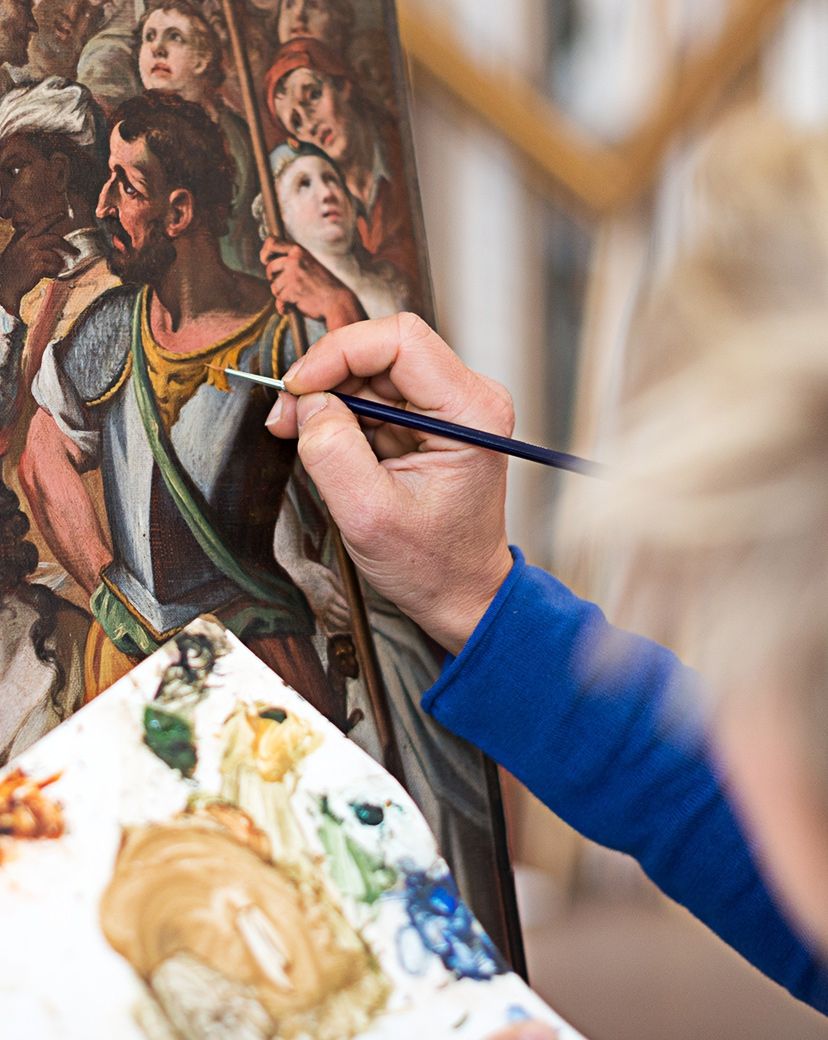
The Art of Restoration: Bringing Masterpieces Back to Life
The Cézanne hadn't been seen in public for forty-seven years. Hidden in a private collection, it had
suffered decades of improper storage, amateur restoration attempts, and the simple ravages of time.
When we first examined it, art conservation specialists shook their heads grimly. The painting that once
commanded millions at auction was now a shadow of its former glory.
Eighteen months later, that same Cézanne sold at Christie's for $23.7 million—more than double its
previous auction record. The difference? Professional restoration that didn't just repair damage but
revealed beauty that had been hidden for nearly half a century.
This is the miracle of art restoration—the delicate dance between science and artistry that can resurrect
masterpieces from near-destruction.
When Art Needs a Doctor
Art restoration is medicine for masterpieces. Like human patients, artworks develop ailments over time:
age spots (foxing), circulation problems (cracking), skin conditions (surface grime), and sometimes trauma
from accidents or poor treatment. The best restoration specialists are part scientist, part artist, and part
detective—solving mysteries while healing wounds that threaten cultural treasures.
The $50 Million Leonardo Discovery: In 2017, a painting dismissed as a workshop copy was revealed to
be an authentic Leonardo da Vinci after restoration removed centuries of overpainting and grime.
"Salvator Mundi" became the most expensive painting ever sold at auction. The restoration didn't create
value—it revealed value that had been hidden for centuries.
The Science Behind the Magic
Modern art restoration combines traditional craftsmanship with cutting-edge technology:
X-Ray Analysis: Reveals hidden layers, previous restorations, and structural damage invisible to the
naked eye. We can see what lies beneath the surface before making any intervention.
* Spectroscopic Analysis: Identifies original materials and later additions, helping conservators distinguish
between artist's work and subsequent alterations.
* Digital Mapping: Creates detailed damage maps that guide restoration priorities and document
progress throughout the process.
* Micro-Photography: Magnifies surface details to cellular levels, revealing the artist's exact techniques
and helping match restoration work to original methods.
The Restoration Dilemmas
Every restoration project faces philosophical questions that require expertise, judgment, and deep
understanding of art history.
* How Much is Too Much?: Should restoration simply stabilize existing damage or attempt to return the
piece to its original appearance? Different approaches can dramatically affect both appearance and value.
* Original Intent vs. Current Condition: When an artist's original vision conflicts with how the piece has
aged, which should take precedence? Some collectors prefer the patina of age; others want to see the
work as the artist intended.
* Reversibility Requirements: Modern restoration ethics require that all interventions be reversible by
future conservators using better techniques. This limits options but protects artworks from irreversible
mistakes.
The $3.2 Million Miracle Recovery
A collector inherited a Monet water lily painting that had been severely damaged in a house fire sixty
years earlier. Previous restoration attempts in the 1970s had used techniques now known to be harmful,
and the painting was considered beyond salvage by several experts.
Our restoration team spent two years developing a recovery strategy
* Phase 1 - Archaeological Investigation: X-rays and spectroscopic analysis revealed that 40% of the
original paint surface survived beneath later restoration attempts.
* Phase 2 - Damage Reversal: Carefully removing harmful previous restoration materials without
disturbing original paint layers.
* Phase 3 - Stabilization: Strengthening the canvas and paint surface to prevent further deterioration.
* Phase 4 - Aesthetic Recovery: Using period-appropriate materials and techniques to restore visual
coherence while clearly distinguishing restored areas from original work
* Spectroscopic Analysis: Identifies original materials and later additions, helping conservators distinguish
between artist's work and subsequent alterations.
* Digital Mapping: Creates detailed damage maps that guide restoration priorities and document
progress throughout the process.
* Micro-Photography: Magnifies surface details to cellular levels, revealing the artist's exact techniques
and helping match restoration work to original methods.
The Restoration Dilemmas
Every restoration project faces philosophical questions that require expertise, judgment, and deep
understanding of art history:
* How Much is Too Much?: Should restoration simply stabilize existing damage or attempt to return the
piece to its original appearance? Different approaches can dramatically affect both appearance and value.
* Original Intent vs. Current Condition: When an artist's original vision conflicts with how the piece has
aged, which should take precedence? Some collectors prefer the patina of age; others want to see the
work as the artist intended.
* Reversibility Requirements: Modern restoration ethics require that all interventions be reversible by
future conservators using better techniques. This limits options but protects artworks from irreversible
mistakes.
The $3.2 Million Miracle Recovery
A collector inherited a Monet water lily painting that had been severely damaged in a house fire sixty
years earlier. Previous restoration attempts in the 1970s had used techniques now known to be harmful,
and the painting was considered beyond salvage by several experts.
Our restoration team spent two years developing a recovery strategy:
* Phase 1 - Archaeological Investigation: X-rays and spectroscopic analysis revealed that 40% of the
original paint surface survived beneath later restoration attempts.
* Phase 2 - Damage Reversal: Carefully removing harmful previous restoration materials without
disturbing original paint layers.
* Phase 3 - Stabilization: Strengthening the canvas and paint surface to prevent further deterioration.
* Phase 4 - Aesthetic Recovery: Using period-appropriate materials and techniques to restore visual
coherence while clearly distinguishing restored areas from original work.
The result? A painting that had been worth perhaps $200,000 in its damaged state was conservatively
valued at $3.2 million after restoration. More importantly, a significant work by one of art history's
masters was saved for future generations.
The Portrait Restoration Challenge
Portrait restoration presents unique challenges because human faces are so familiar that even subtle
errors become obvious. When we restored an 18th-century portrait by John Singer Sargent, the subject's
descendant provided family photographs that helped guide facial reconstruction work.
The painting had suffered water damage that obscured the subject's left eye and part of her smile. Using
historical records, family photographs, and advanced digital modeling, our conservators recreated the
missing features with such accuracy that the subject's great-granddaughter wept when she saw the
completed restoration.
"It's like meeting my ancestor for the first time," she said. "I can finally see the woman my great grandfather described in his letters."
The Corporate Collection Restoration Project
A Fortune 500 company's headquarters housed a collection of 73 pieces, many of which had suffered
from decades of display in less-than-ideal conditions. Fluorescent lighting, temperature fluctuations, and
urban pollution had taken their toll.
Our comprehensive restoration program included
- Condition assessments for all 73 pieces
- Environmental improvements to prevent future damage
- Phased restoration prioritized by piece importance and damage severity
- Preventive conservation training for facilities staff
- Ongoing maintenance programs to preserve restoration work
The project took three years and transformed not just individual artworks but the entire corporate
environment. Employee satisfaction surveys showed significant improvements in workplace morale and
pride. The restored collection became a powerful recruiting tool and a source of genuine corporate pride.
The Authentication Revelation
Sometimes restoration reveals more than just beauty—it reveals truth. When cleaning a painting
attributed to a minor 19th-century artist, our conservators discovered a signature hidden beneath layers
of overpainting. Further investigation revealed the work to be by a major American impressionist,
increasing its value from $50,000 to $1.8 million.
This discovery illustrates why proper restoration requires not just technical skill but deep art historical
knowledge. The conservator who made this discovery had studied American impressionism for thirty
years and recognized subtle stylistic elements that less experienced restorers might have missed.
The Preventive Conservation Philosophy
The best restoration is the restoration that never becomes necessary. Our preventive conservation
services help collectors maintain their pieces in original condition through:
* Environmental Monitoring: Continuous tracking of temperature, humidity, and light exposure to
prevent damage before it occurs.
* Condition Assessments: Regular professional examinations that identify minor issues before they
become major problems.
* Proper Display: Museum-quality framing, mounting, and lighting that protect while enhancing
presentation.
* Handling Protocols: Training for collectors and staff on proper artwork handling to prevent accidental
damage.
The Ethics of Restoration
Modern restoration follows strict ethical guidelines designed to preserve artistic integrity while ensuring
long-term survival:
* Minimal Intervention: Only doing what's necessary to stabilize and preserve the artwork.
Documentation: Maintaining complete records of all work performed, materials used, and decisions
made.
* Reversibility: Ensuring future conservators can undo current work if better techniques become available.
* Transparency: Clearly distinguishing restored areas from original work in documentation and, when
appropriate, in the work itself.
The Emotional Restoration
Beyond technical and financial considerations, restoration often carries profound emotional weight. When
we restored a family portrait damaged in Hurricane Katrina, the work wasn't just about preserving a
painting—it was about preserving family history, memory, and connection to ancestors.
The collector's grandmother had commissioned the portrait in 1923. It had survived the Great Depression,
World War II, and decades of family changes. The hurricane damage threatened to end that story.
Professional restoration ensured the portrait would continue telling that family's story for future
generations.
Your Collection's Future
Every artwork in your collection will eventually need conservation attention. Paint ages, canvas weakens,
frames deteriorate, and environmental factors take their inevitable toll. The question isn't whether your
pieces will need restoration—it's whether they'll receive the expert care that preserves their beauty, value,
and historical significance.
Professional restoration isn't just about fixing damage—it's about ensuring your collection continues to
inspire, educate, and delight for generations to come. When art needs healing, trust it only to those who
understand that they're not just working on objects—they're preserving cultural treasures.
Is your collection showing signs of age or damage? Contact The Art Guys and let our restoration specialists
help preserve your artistic treasures for future generations
Read more — Next article

From Warehouse to Wall Art
The auction hammer falls. The crowd erupts. You've just acquired the painting you've dreamed of owning for years. But between that electrifying moment and seeing it grace your wall lies a journey fraught with invisible dangers that could turn your dream into a nightmare.
View Article
